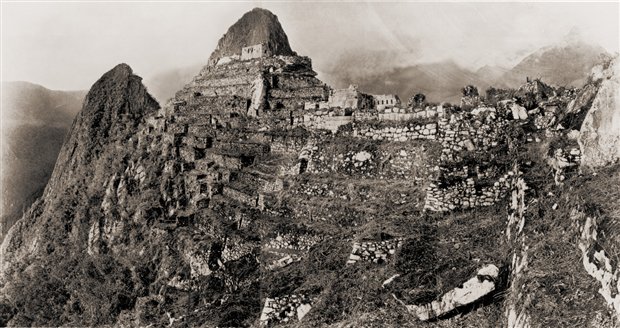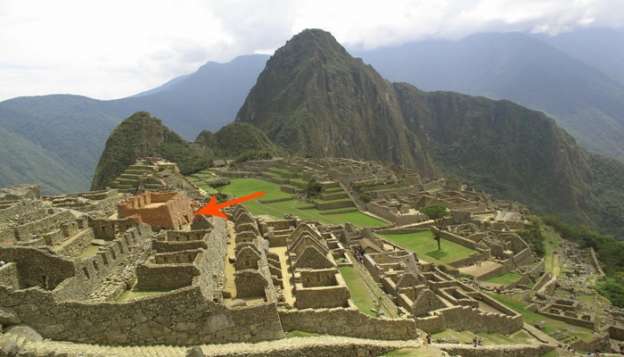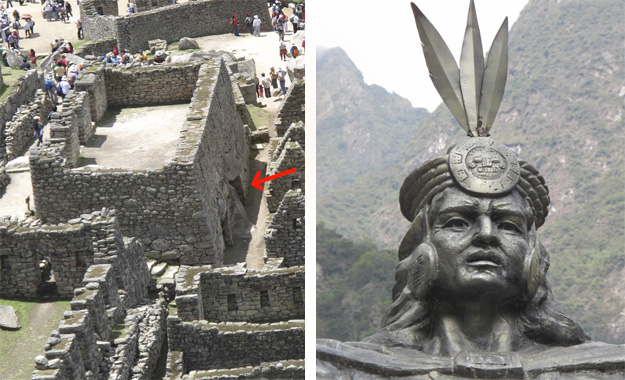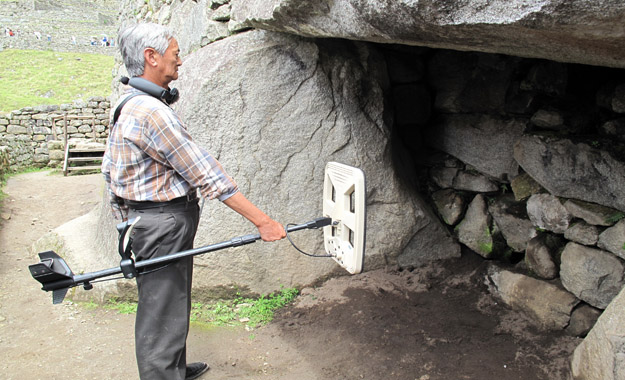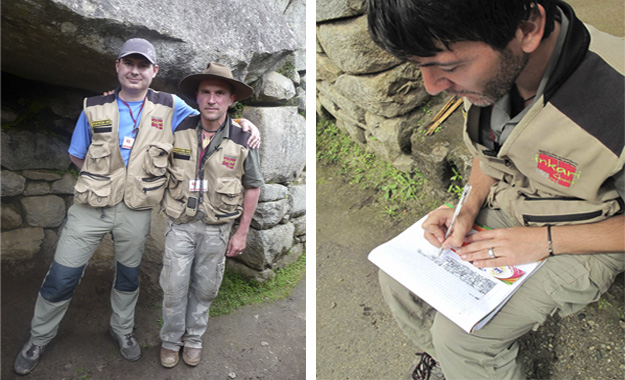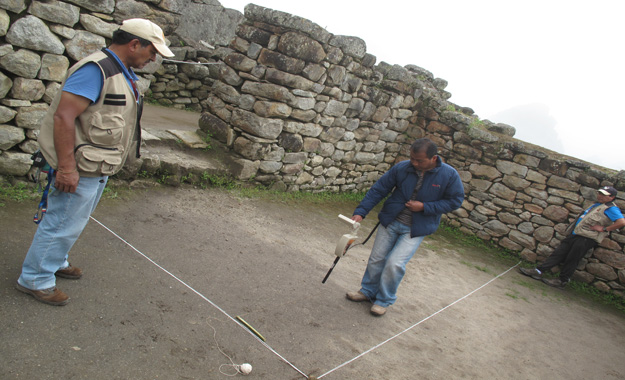Possible Mausoleum with Gold, Silver & Mummies Discovered at Machu Picchu
posted on February 8th, 2013 in Incas, Machu Picchu, Recent Discoveries
Machu Picchu Inkari Research Institute discovers Inca mausoleum with large quantities of gold and silver. However, the [Peruvian] Ministry of Culture has stalled the project.
Rumbos
Feb 8, 2013
(Translated by Kim MacQuarrie)
Who would believe it? Millions of tourists and thousands of archaeologists have walked before the walls that hide perhaps the best kept secret of Peruvian archeology: the final resting place of the Inca [emperor] Pachacutec.
However, a twist of fate allowed the French engineer, David Crespy, stranded for three days in [the Peruvian town of] Aguas Calientes [at the base of Machu Picchu] because of a landslide that prevented him from returning to Cusco, to have the time to examine Machu Picchu from the top down. On one of those walks, he came to a solid wall that, at its core, had a sort of opening.
“This is a door,” Crespy immediately thought, unaware that some funny or bright tourists, depending on how you view it, had written on the stone above the entrance the word “treasure” and had drawn an arrow pointing to it.
Crespy contacted some Machu Picchu archaeologists, and they assured him that they would investigate the matter. Back in Europe, the French engineer persisted with his inquiry, but received no response from the authorities. Crespy even visited the Peruvian Embassy in France, and the [Peruvian] consulate in Barcelona, where he lives, but received zero interest. It had already been a year, and he was just about ready to throw in the towel.
It was then that he read in Le Figaro Magazine an article by Thierry Jamin, a French archaeologist obsessed with carrying out expeditions [to search for the fabled lost city of] Paititi for 15 years in southeastern Peru, and had discovered 113 new sites in the process. A number of those are currently in the process of being rated as part of Peru’s cultural heritage. Crespy wrote Jamin an email telling him about his adventures and about his crazy idea that Machu Picchu could hold a treasure trove.
A little skeptical because, like other researchers, Thierry thought everything had been studied at Machu Picchu to the point that every stone had a number, he visited the Inca citadel and had the same impression as his compatriot.
Without wasting any time, the Inkari Institute of Cusco, of which Thierry is president, readied a project that would apply an electromagnetic resonance gun to the building identified at Machu Picchu by Crespy, and presented the project to the Ministry of Culture on December 19, 2011. On March 22, 2012 the project was approved.
The Inkari institute then coordinated with Fernando Astete, head of the Machu Picchu Archaeological Park, in order to establish the dates for carrying out the electromagnetic testing.
Everything seemed to go well. But when work began on April 12, 2012, they were suddenly surrounded by a crowd of park employees who took photos, made sketches and notes, recorded conversations, filmed everything, and asked questions insistently. Their behavior certainly went against professional ethics and regulations and ignored the general provisions of research done under the Ministry of Culture itself.
At the end of that day, Thierry was talking with [the Peruvian archaeologist] Astete, pointing out that what had happened was not normal. This apparently did not set well with the head of the park, because the next day the Inkari Institute researchers were stopped, the park officials arguing that one of the serial numbers on their equipment was incorrect. They had to turn to authorities at the Ministry of Culture to let them enter again, so that they could complete their studies.
Despite these obstacles, the results were amazing and beyond anything imagined. Using geo-radar that allowed them to have a 3D view and to analyze the ground to a depth of 20 meters (66 feet), they were able to discover the existence of a large burial chamber, with a considerable amount of gold and silver, and a whole underground structure that housed a dozen cavities which presumably corresponded to an equal number of graves, some of which were very small and may be those of children.
They also discovered the existence behind the access door of a staircase lined with a gold plate, which leads precisely to the main chamber.
“The time, dedication and the material used in this building tell us that it could only be for a very important person. There may be a curaca or a priest who is buried there, and this just may be the final resting place of an actual panaca [royal lineage], possibly the panaca of [the emperor] Pachacutec ,” says Thierry Jamin.
Indeed, [Peruvian] archaeologist Luis Lumbreras maintains that Machu Picchu is a sanctuary and a fortress and was [also] the mausoleum of the Inca Pachacutec. The [16th century Spanish] chronicler Juan de Betanzos said that Pachacutec’s mummy was at Patallacta (“the edge”), and for Lumbreras “Patallacta” must have been the name he gave to the Inca citadel of Machu Picchu as its [current] name (“old mountain” ) does not make much sense. “Betanzos was a Spanish soldier who married Dona Angelina, of the dynasty of Pachacutec, so she would have given him that information,” said Lumbreras.
How to know if Pachacutec is buried under the building of the three portals? “Pachacutec was 90 years old at the time of his death, so the mummy must belong to someone very old. In addition, there are some symbols that may identify him, such as his belongings, [the presence of a] a scepter, and his clothing, “argues Thierry.
Regarding the characteristics of the wall that seals the mausoleum, Inkari executive secretary and archaeologist Daniel Merino said that “the first thing I noticed were the stones that blocked the entrance to the chamber and that these had been placed in an irregular manner, without any mortar. This means that because of some significant event in the region, they unexpectedly decided to cover it. ”
The idea that the Incas closed the access opening due to an emergency that perhaps was caused by the Conquest is shared by Thierry. “The Incas probably hid their treasure from Cuzco the Incas during the chaos of the fall of the empire. They might be, and it gives me goose bumps when I say this, treasures brought from [the Inca Sun Temple in Cuzco called] Coricancha and other sacred temples, “says the French archaeologist.
A few years ago, archaeologists were searching for the tomb of Pachacutec on Huayna Picchu [the peak adjacent to Machu Picchu], because they believed that everything had been studied within the citadel itself. They thought it was impossible to discover something of this importance within the main citadel. But actually, Machu Picchu studies have been limited to issues of conservation or geological faults and have not investigated the subsoil where there are many galleries and tunnels waiting for the attentive eyes of archaeologists.
The first draft of the report was approved by the Ministry of Culture. The Inkari Institute then presented a second draft, which this time included excavating, if needed, in order to unravel this historic mystery. On November 5, 2012, however, Ana Maria Hoyle, in charge of the Directorate General of Cultural Heritage, refused to authorize the second project.
For Thierry Jamin, the responsibility for this negative response is due to Fernando Astete. “To allow us to go ahead requires the “technical opinion” of those in charge of Machu Picchu, and as Fernando Astete knows the importance of the discovery and wants to take control of the project, he has not provided a fair technical opinion,” the French researcher argues.
Actually, Astete did not sign off on this “technical opinion” because he is not an archaeologist. Instead Piedad Champi, director of the Park, signed it. The technical opinion noted that the project is not within the guidelines of the Master Plan of Machu Picchu and said that [the proposed team members] “know little or nothing about conservation,” and that the opening of the wall would generate “structural instability problems.” It also suggested that the Inkari Institute is searching for precious metals without taking into account their historical context.
Daniel Merino refutes these findings and states that “we comply with the Master Plan and we would have liked for them to tell us why they think we do not. The project is well structured, with a good hypothesis, appropriate methodology and scientific criteria. We have a competent multidisciplinary team, with a good track record, but they treat us as if we were looters. These are subjective opinions. Piedad Champi’s conservation considerations have surprised us, because it can hardly be disputed the expertise of a world authority on the subject such as Victor Pimentel, who is on Inkari team. ”
As to the [tehcnical reports’ opinion about] “structural instability,” Inkari’s legal defense indicates that these are civil engineering opinions, a competency in which the [director of the park and] archaeologist Champi does not possess. And they [the Inkari Institute] has a report by a civil engineer, Cesar del Carpio, who ensures that the opening of the wall will not alter the structure of the compound.
Thierry Jamin says specifically that “georadar does not lie, is not our fault that the archaeologists of Machu Picchu, many with 20 or 30 years [of experience] in the park, have overlooked this discovery.” He adds: “We want a re-evaluation of the project by impartial archaeologists, independent of Fernando Astete’s team It does not seem to me either moral or profession to have us removed from the project.”
In early December [2012] the Inkari Institute filed an appeal, which the Ministry must decide upon shortly. It would be a shame that what could be the most important archaeological find of the last decades, will get caught up in trifling obstacles only a short distance away from the historic grandeur of Machu Picchu.

